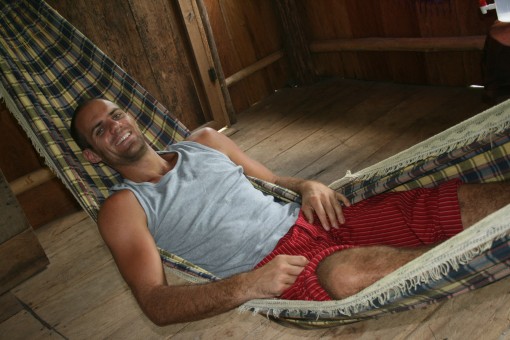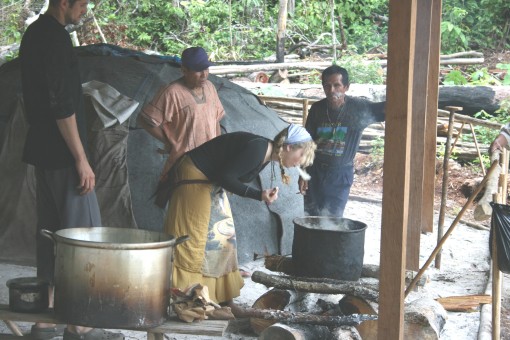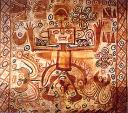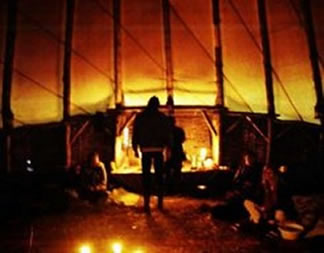Shamans believe that the soul can be lost through trauma, abuse, shock – and, fundamentally, by dishonouring nature or ignoring our need to connect with it. In many shamanic countries, there are still roadside shrines where people can rest, pay their respects to the natural world, and receive healing and replenishment from it. In the modern West, we have few such sacred places or ceremonies of connection left. Festivals such as May Day, originally a fertility ritual to welcome the coming of Spring, have lost much of their purpose and meaning, and our connection to nature is weakened. In turn, our souls, individually and collectively, have become weak and, despite our great wealth and ‘power’, many traditional societies regard us as the poorest people on Earth. Healing soul loss, as you might sense from this, often involves the shaman reconnecting his patient to nature, so she is restored to balance and her spirit has a safe, strong, whole, place to return to. In Japan, one method is to accompany the patient (or advise her to go on her own) on a walk into nature to find and make contact with a particular tree that calls to her. She then sits down with her back to it and speaks to the tree of her problems and sorrows. If she listens closely, the spirit of the tree – the great gateway to nature – will counsel her on what to do, while at the same time taking and transforming her pains and giving her power and new spirit in return. In Tuva, the patient is advised to take a similar walk and make an offering to a nature shrine, in return for which the spirits will bring back her soul. In both cases, of course, the patient is deeply immersed in nature, at one with the trees and held in the peace of the forest, which is itself invigorating and restful. In the Andes, soul retrieval is a similar but slightly different practice. Here, the shaman will accompany the patient to the physical location where soul was lost to find and bring back its energy. There is always a physical location where trauma occurred, whether an accident blackspot where a car crash took place or a home at the centre of childhood abuse, and that is where the soul remains locked. The shaman is able to bring back the soul by negotiating for its release with the spirit of this place and by enticing the soul to return by singing to it of the joys that await it back in the patient’s body now that the trauma has ended. In negotiating with the spirit of place, the shaman may also make an offerenda in exchange for the soul, or simply leave flowers. If the spirits of nature are satisfied with the offering and reassured that the soul they are protecting will be treated well on its return – and if the soul itself feels loved and safe – it will be released to the patient straight away. Andean curandera, Doris Rivera Lenz, comments on this practice as follows: When a child falls suddenly, for example, its soul can leave its body and it may get ill. If this happens, an offering is made in the place of the fall, to heal the child. There are many ways to ‘call the soul’. You can get hold of a piece of the child’s clothing and make a little doll and decorate it with flowers or whatever the child likes, and you call his soul in the place where the fright took place. You can also call up and use the energies of herbs, a dove’s nest, feathers, tobacco, coca, or whatever else is needed to help with this healing, but before any session, you must first ask permission from Pachamama, the spirit of the Earth. If there is no fixed place where the problem began, then you go to the highest mountain or closest river and perform the ritual there. There is another approach to soul retrieval, common in countries as diverse as Mexico, Haiti, and Peru, which also works with flowers. In these traditions it is believed that the soul can sometimes be, not lost exactly, but so loosely attached that it is vibrating inside and outside the body at one and the same time. This can happen as a result of shock, where events that shake our worldviews and undermine all that we thought to be true can also set our spirits shaking. It is as if we have nothing left to hold on to and all of our balance is gone. Shocks like these can lead to trauma but if the soul is caught quickly enough it can be healed before deeper wounding occurs, by forcing it back into the body and stabilising it there so that balance is restored. One method is to swaddle the patient tightly in sheets or blankets so that the soul is compressed back into the body and held there. This may also be the origin of the practice of swaddling babies, traditional people recognising that the soul of a baby is less attached to its physical body and needs to be held in place until the child has ‘grown into itself’ and become established in its body. Inside the blanket are placed flower petals and they may also be sprinkled on top of and around patient. As the patient lies in her sweet-smelling cocoon of flowers that soothe the soul, the shaman will sing to her in lullabies and whispers of how beautiful the world is and how she is loved and wanted by her people. Perfumes may also be sprayed over her, their smells anchoring her memory of the sweet words she is hearing, and the prayers offered for her soul and to the spirits of nature. Then she is left there for a while in the gentle heat of a rising sun, before the shaman unwraps her and welcomes her home as an initiation into a new possibility of life: a rebirth through flowers. Another method is that related by the Mexican medicine man, don Abraham, who speaks of the alta miza herb, which is “used to heal traumas, to make a regression”. “Alta miza grasps your spirit and moves you backwards… until you reach the place which hurts. And then she confronts you with the pain. And she will heal the pain”. [Mexican teachings: Plant Spirits in Ceremony]. This is similar to the Amazonian use of the chacapa to remove negative energies and restore spirit to a patient. In both cases, it is the plants, directly, that offer the healing. Interestingly, as well, alta miza is feverfew, which has long been respected for its properties of healing and purification, and was widely planted in old England in the belief that it would purify the air and prevent the spread of plague. Gerard said of it that it “cleanseth, purgeth or scoureth, openeth, and fully performeth all that bitter things can do”. Plant Spirit Shamanism understands that plants have an affinity for human beings, that they know our pain, and that their intention is to love and to heal. Simply being close to them and their energy fields can be enough to call back the soul. Join us for an authentic experience of ayahuasca, San Pedro, and plant spirit shamanism in the beautiful rainforests and mountains of Peru. Email ross@thefourgates.com for a FREE Information Pack or visit the website http://www.thefourgates.com and look under the Sacred Journeys section.





